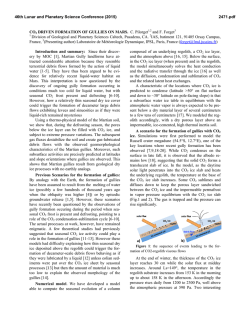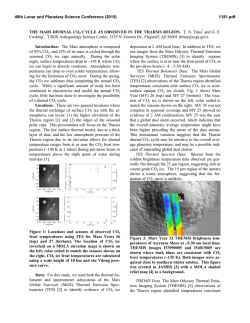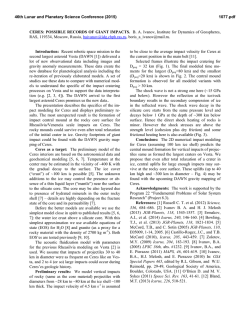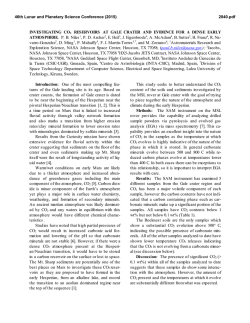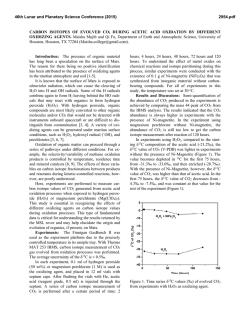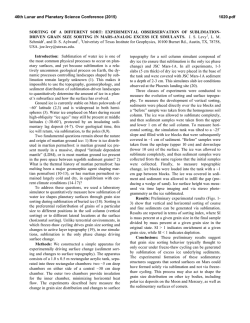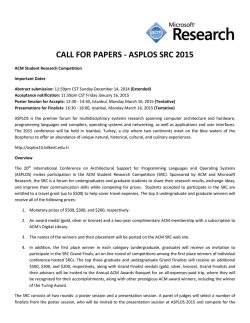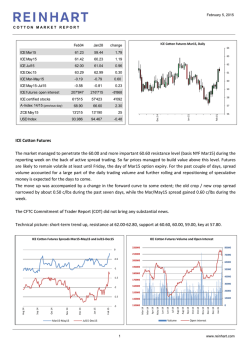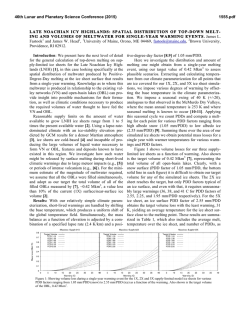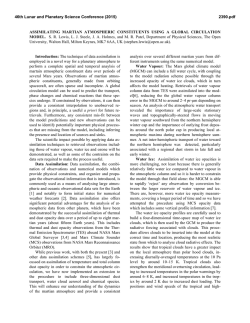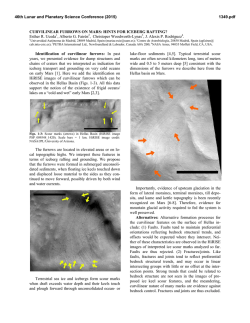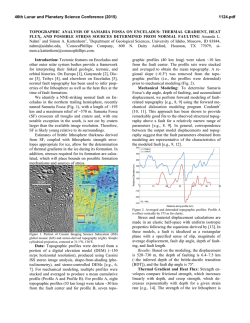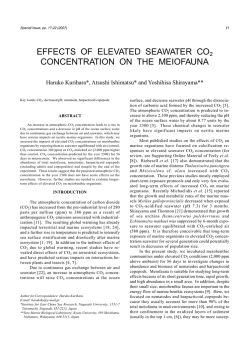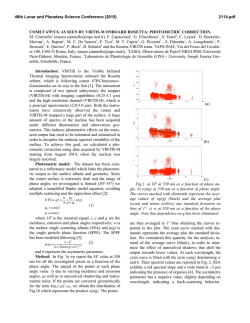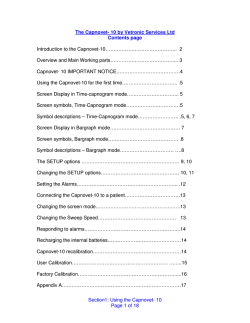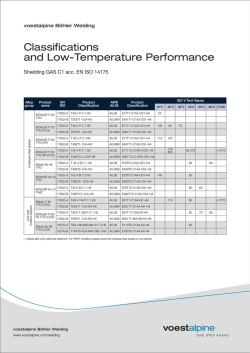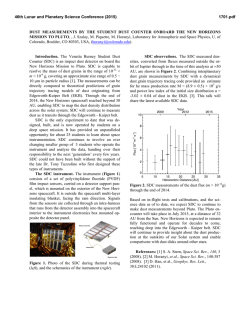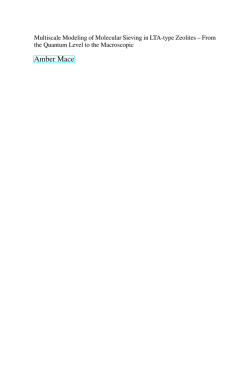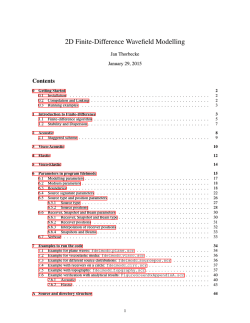
Evolution and Stability of the Residual CO
46th Lunar and Planetary Science Conference (2015) 1657.pdf EVOLUTION AND STABILITY OF THE RESIDUAL CO2 ICE CAP. S. Byrne1 P.O. Hayne2, P. Becerra1 and the HiRISE Team1, 1Lunar and Planetary Lab, University of Arizona ([email protected]) 2Jet Propulsion Lab Introduction: The southern residual ice cap (SRC) is composed in-part of high-albedo solid CO2 [1]. It buffers the current atmosphere and probably stabilizes a buried CO2 reservoir [2] at least 20 times its size. Yet this critical deposit is apparently being eroded at a prodigious rate calling into question the stability of the current martian climate [3]. Here, we tie observations of the SRC surface and overlying atmosphere by Mars Reconnaissance Orbiter (MRO) together with landscape evolution models that predict, not a stable cap, but rather one that waxes and wanes over timescales of ~102 years. Our results imply large dust storms provide a mechanism that allows regrowth of the cap and so play a crucial role in stabilizing the current climate. needed to remove the ice by these expanding features. In contrast, other sections of the SRC lack these pits and show little change, but may be accumulating or ablating vertically. Only small changes in SRC extent have occurred in recent decades [12]. Figure 2. DTMs at times indicated of a typical model run of a CO2 landscape. (Right) minimum, mean and maximum CO2 ice thicknesses as a function of time. Figure 1. All panels are 1 km2 and illuminated from the right. (Left) Two examples of SRC terrain with pit densities of ~1 and ~100 km-2. (Right) DTMs (elevation scale in Fig. 2) of model results for higher (top) and lower (bottom) smoothing efficienies. The SRC is on the order of a few meters thick [4-5] and has areas at its margins and in its interior where underlying water ice shows through [4-7]. Its stability today depends critically on its ability to maintain a high albedo [8,9]. It contains abundant flat-floored, quasi-circular pits (Fig. 1) with a wide range of spatial densities that are embedded in CO2 ice slabs that vary in thickness from 2 to 10 meters [10]. The inclined walls of these quasi-circular pits retreat by several meters each year [3,5,11] leading [3] to suggest that the SRC is in the process of disappearing, causing the martian climate to change. Indeed, when one looks at the spatial density of these pits and the rates at which they are expanding, there should be nothing left of those sections of the SRC within a century or so. However, a changing climate is unexpected as the orbit of Mars changes on timescales much longer than the time Model: In our landscape evolution model CO2 ice elevation falls or rises via ablation or condensation due to imbalances in surface energy budgets. In a typical model run (Fig. 2), we initiate the model with a randomly generated fractal surface with a thin CO2 ice cover whose surface roughness is low. The surface begins accumulating; however, surface roughness also increases with time. After about 30 years, instabilities begin to occur in the locations with the highest slopes. Pits begin to form and quickly penetrate down to the water ice basement. Over the following decades these pits expand laterally (by a few m/yr) even while the intervening flat surfaces continue to accumulate mass vertically. As the accumulation area (mesa-tops) shrinks, and the ablation areas (pit perimeters) grow, the landscape as a whole passes from a net accumulation to a net ablation regime. The right panel of Fig. 2 illustrates the behavior of the mean CO2 thickness (which is a proxy for total volume of ice). Many SRC locations are close to the final state in this model, where only isolated (and shrinking) mesas remain as remnants of the original ice slab. This overall behavior is an inevitable consequence of starting with a surface that is not perfectly flat; CO2 ice caps can never be stable indefinitely. The final surface is covered with a thin rugged layer of CO2 ice too rough to allow systematic growth of a new ice sheet. 46th Lunar and Planetary Science Conference (2015) Understanding that surface roughness governs the lifespan of the ice cap allows us to resolve how it is that the SRC persists to this day. Extra CO2 deposition alone does not reduce surface roughness. Rather we require some surficial CO2 ice to be mobile and capable of filling in small-scale roughness (treated mathematically as diffusion) e.g. snowfall and slumping of slopes. Once smoothed in this fashion, CO2 may begin accumulating again and a new cap will grow (Fig. 3) that will be in-turn destroyed by expanding pits in a cyclic process. Each cap differs in exact appearance, but is identical in behavior (Fig. 3). The efficiency of this smoothing directly controls the pit spacing (Fig. 1). Some parts of the SRC are windier leading to more efficient snowdrift and so different geomorphology. Interannual variability in the availability of loose surficial material is required. Roughness must be allowed to increase in some years to form pits and must decrease in others to allow new CO2 caps to form. Observational confirmation: The model described above has several predictions/requirements in order to work. MRO datasets have confirmed most of these. • Expanding pits: Observed since 2001 [3] with expansion rates measured at a few m/yr [5,11]. • Net accumulation on flat surfaces: The behavior of ephemeral albedo features in MY28 and refrosting of dark areas in MY29-31 indicate that the SRC is in a state of net accumulation today [13]. • Loose surficial material: CO2 snowfall has been detected by the Mars Climate Sounder concentrated above the SRC and may comprise up to a few tenths of the total seasonal surface CO2 [14]. We have observed localized defrosting of SRC areas in response to the MY28 summer global dust storm 1657.pdf that was reversed over subsequent years [13]. A similar pattern was observed by Mariner 9 and Viking after the MY9 global storm. Atmospheric dust also drives enhanced snowfall the following winter, both by providing condensation nuclei to a sub-saturated atmosphere and cooling the atmosphere (dust is a much more effective emitter of heat than CO2 gas). Both HiRISE and historical imagery suggest the winters following global dust storms have higher than usual deposition. Models (e.g. [14]) show that dusty winters will also produce the most snowfall. We suggest that the dust storms provide the interannual variability that the SRC needs to survive. Our results suggest the thickest portions of the SRC likely record a few 10s of these smoothing events. Summary: No climate change is necessary to explain the current erosion of the SRC; expanding pits exist at all phases of its life cycle. As different parts of the cap are at different stages of this cycle no systematic pressure changes (+ or -) are predicted for the current atmosphere. Interannual variability in the form of winters with above-average snowfall is required to explain a recurring SRC and the fact that different parts of the current SRC are at different stages of the life cycle. Historical and MRO data suggest that these winters are preceded by large dust storms. References: [1] Kieffer, JGR, 1979. [2] Phillips et al., Science, 2011 [3] Malin et al., Science, 2001. [4] Byrne & Ingersoll, Science, 2003. [5] Thomas et al., Icarus, 2005. [6] Titus et al., Science, 2003. [7] Bibring et al., Nature, 2004. [8] Jakosky and Haberle, JGR, 1990. [9] Guo et al., JGR, 2010. [10] Thomas et al., Nature, 2000. [11] Thomas et al., Icarus, 2009. [12] Piqueux & Christensen, JGR, 2008. [13] Becerra et al., Icarus, 2015. [14] Hayne et al., Icarus, 2014. Figure 3. (Top) Evolution of mean (dashed) and max (solid) CO2 ice thickness when diffusive resurfacing is included. Red lines are spaced every ten martian years and correspond to landscapes shown in the left-hand panels (colors correspond to elevation scale in figure 2).
© Copyright 2025
